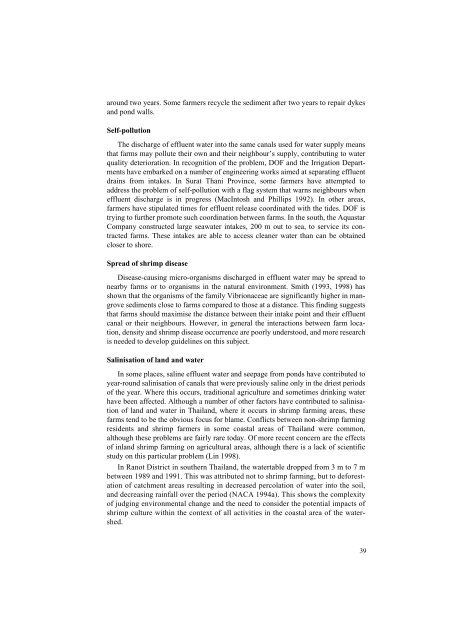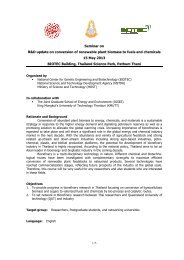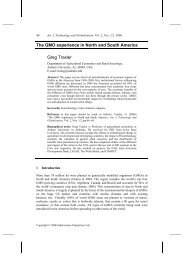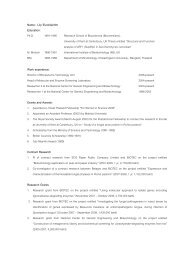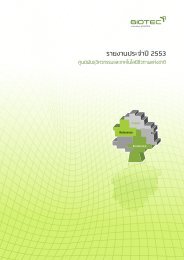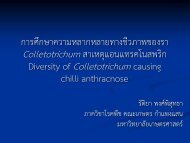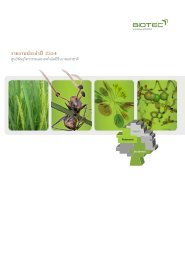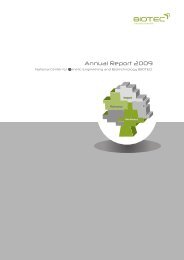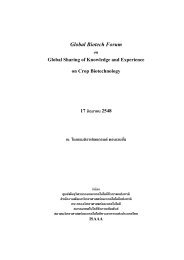dur<strong>in</strong>g the ra<strong>in</strong>y season, some deterioration of <strong>in</strong>shore water quality has been noted attimes.Elsewhere, and notably <strong>in</strong> the Upper Gulf of <strong>Thailand</strong>, the nutrient loads fromcoastal shrimp farms have been shown to be <strong>in</strong>significant when compared to othersources of the coastal nutrient loads, particularly nitrogen and phosphorus from agriculturaland domestic sources (Pollution Control Department 1997).Treatment of effluent waterOn smaller farms, most effluent water is discharged without treatment. Wherewater is treated, settlement ponds are the most commonly used method. These areeffective at decreas<strong>in</strong>g the levels of phosphorus, dissolved nitrogen and suspendedsolids, but BOD can <strong>in</strong>crease because of the high nutrient levels <strong>in</strong> the ponds andbecause of phytoplankton blooms (Briggs and Funge-Smith 1994). On larger farms,greater than 50 rai, Thai Government regulations that came <strong>in</strong>to effect <strong>in</strong> 1991 stipulatethat effluent must be treated via settlement ponds of a size equivalent to or largerthan 10% of the total farm area.In one study, the required size of settlement ponds was calculated from measurementsof the settl<strong>in</strong>g velocity of particulate matter <strong>in</strong> the effluent (Smith 1995). A settlementpond of 0.75 ha <strong>for</strong> an effluent discharge of 1 m 3 /s was found to be suitable.The study showed that more than 90% of the diatomaceous silica (<strong>in</strong> diatom shells)that accumulated <strong>in</strong> ponds was derived from the weather<strong>in</strong>g of clay from pond walls.Also, the effluent conta<strong>in</strong>ed a high level of <strong>in</strong>organic material that was eroded fromthe soil <strong>in</strong> the ponds. Consequently, much can be done to reduce sediment load<strong>in</strong>gsby improv<strong>in</strong>g soil conservation on the farm, and particularly through the use of l<strong>in</strong>ersand other methods to keep pond walls <strong>in</strong>tact.Biological methods of water treatment have been <strong>in</strong>vestigated <strong>in</strong> <strong>Thailand</strong> and elsewhere.The green mussel Perna viridis has been trialled (DOF 1992) with some successat reduc<strong>in</strong>g BOD, organic solids and phytoplankton. This mussel, however, is sensitiveto sal<strong>in</strong>ity fluctuations and its production of faeces and pseudo-faeces may add to sedimentloads. The seaweed Gracilaria has been grown <strong>in</strong> conjunction with green musselsand shown to reduce soluble nutrients. Un<strong>for</strong>tunately it is also sensitive to sal<strong>in</strong>ity fluctuations,and <strong>in</strong> turbid and eutrophic pond effluent suffers from light limitation, as wellas smother<strong>in</strong>g by sediment and epiphytic microbial growth. Currently under <strong>in</strong>vestigationat the Petchaburi <strong>Coastal</strong> <strong>Aquaculture</strong> Centre is the use of a native seagrass.Various groups of bacteria are under exam<strong>in</strong>ation to assess their usefulness <strong>in</strong> accelerat<strong>in</strong>gthe breakdown of pond wastes (Keawchum 1993).Sediment disposalSediment from ponds is usually removed at the completion of the productioncycle. NACA (1994a) found that 36% of surveyed farms dumped sediment along thepond dykes, 36% <strong>in</strong> designated sediment disposal areas, and the other farms disposedof it elsewhere. Discharge of pond sediment <strong>in</strong>to water bodies has the potential toaffect them <strong>in</strong> a similar way to effluent water, but there is a high degree of awarenessamong farmers of this problem and most places of disposal are now away fromwaterways. Because it is high <strong>in</strong> sal<strong>in</strong>ity, it is not colonised readily by most plantsuntil the ra<strong>in</strong> has had chance to wash away some of the salt, which usually takes"'
around two years. Some farmers recycle the sediment after two years to repair dykesand pond walls.Self-pollutionThe discharge of effluent water <strong>in</strong>to the same canals used <strong>for</strong> water supply meansthat farms may pollute their own and their neighbour’s supply, contribut<strong>in</strong>g to waterquality deterioration. In recognition of the problem, DOF and the Irrigation Departmentshave embarked on a number of eng<strong>in</strong>eer<strong>in</strong>g works aimed at separat<strong>in</strong>g effluentdra<strong>in</strong>s from <strong>in</strong>takes. In Surat Thani Prov<strong>in</strong>ce, some farmers have attempted toaddress the problem of self-pollution with a flag system that warns neighbours wheneffluent discharge is <strong>in</strong> progress (MacIntosh and Phillips 1992). In other areas,farmers have stipulated times <strong>for</strong> effluent release coord<strong>in</strong>ated with the tides. DOF istry<strong>in</strong>g to further promote such coord<strong>in</strong>ation between farms. In the south, the AquastarCompany constructed large seawater <strong>in</strong>takes, 200 m out to sea, to service its contractedfarms. These <strong>in</strong>takes are able to access cleaner water than can be obta<strong>in</strong>edcloser to shore.Spread of shrimp diseaseDisease-caus<strong>in</strong>g micro-organisms discharged <strong>in</strong> effluent water may be spread tonearby farms or to organisms <strong>in</strong> the natural environment. Smith (1993, 1998) hasshown that the organisms of the family Vibrionaceae are significantly higher <strong>in</strong> mangrovesediments close to farms compared to those at a distance. This f<strong>in</strong>d<strong>in</strong>g suggeststhat farms should maximise the distance between their <strong>in</strong>take po<strong>in</strong>t and their effluentcanal or their neighbours. However, <strong>in</strong> general the <strong>in</strong>teractions between farm location,density and shrimp disease occurrence are poorly understood, and more researchis needed to develop guidel<strong>in</strong>es on this subject.Sal<strong>in</strong>isation of land and waterIn some places, sal<strong>in</strong>e effluent water and seepage from ponds have contributed toyear-round sal<strong>in</strong>isation of canals that were previously sal<strong>in</strong>e only <strong>in</strong> the driest periodsof the year. Where this occurs, traditional agriculture and sometimes dr<strong>in</strong>k<strong>in</strong>g waterhave been affected. Although a number of other factors have contributed to sal<strong>in</strong>isationof land and water <strong>in</strong> <strong>Thailand</strong>, where it occurs <strong>in</strong> shrimp farm<strong>in</strong>g areas, thesefarms tend to be the obvious focus <strong>for</strong> blame. Conflicts between non-shrimp farm<strong>in</strong>gresidents and shrimp farmers <strong>in</strong> some coastal areas of <strong>Thailand</strong> were common,although these problems are fairly rare today. Of more recent concern are the effectsof <strong>in</strong>land shrimp farm<strong>in</strong>g on agricultural areas, although there is a lack of scientificstudy on this particular problem (L<strong>in</strong> 1998).In Ranot District <strong>in</strong> southern <strong>Thailand</strong>, the watertable dropped from 3 m to 7 mbetween 1989 and 1991. This was attributed not to shrimp farm<strong>in</strong>g, but to de<strong>for</strong>estationof catchment areas result<strong>in</strong>g <strong>in</strong> decreased percolation of water <strong>in</strong>to the soil,and decreas<strong>in</strong>g ra<strong>in</strong>fall over the period (NACA 1994a). This shows the complexityof judg<strong>in</strong>g environmental change and the need to consider the potential impacts ofshrimp culture with<strong>in</strong> the context of all activities <strong>in</strong> the coastal area of the watershed."(
- Page 8 and 9: !The 1994 Workshop had a working hy
- Page 11 and 12: !The Workshop at Hat Yai, SongkhlaA
- Page 13 and 14: !ReferenceSmith, P.T., ed.. 1999. T
- Page 15 and 16: !Shrimp Farming in ThailandOver the
- Page 18 and 19: ! !Table 1. World production (# 1,0
- Page 20 and 21: !Domestic and world demandJapan is
- Page 22 and 23: !Intensification of farms has been
- Page 24 and 25: !no significant difference between
- Page 26 and 27: !Production Practices and Technique
- Page 28 and 29: !use water which is almost fresh (F
- Page 30 and 31: !mended quantities for application
- Page 32 and 33: !the biological processes in sedime
- Page 34 and 35: !factors (Fegan 1994). Environmenta
- Page 36 and 37: !Acid sulphate soils occur in most
- Page 40 and 41: Land subsidenceCoastal land subside
- Page 42 and 43: first when an area becomes environm
- Page 44 and 45: !Administration. Their work has inv
- Page 46 and 47: agriculture, selects coastal land p
- Page 48 and 49: Sustainability, Sustainable Develop
- Page 50 and 51: cultural and environmental asset va
- Page 52 and 53: $+Table 12. (cont’d) Impediments
- Page 54 and 55: $#Table 12. (cont’d) Impediments
- Page 56 and 57: $%Table 12. (cont’d) Impediments
- Page 58 and 59: capacities of alternative organisms
- Page 60 and 61: sources. This is one of the greates
- Page 62 and 63: Table 13. (cont’d) Summary of the
- Page 64 and 65: Boonyapiwat, S. 1989. Species of ph
- Page 66 and 67: Katesombun, B. 1992. Aquaculture pr
- Page 68 and 69: Sirisup, S. 1988 Socio-economic cha
- Page 70 and 71: !In the preliminary analysis, the s
- Page 72 and 73: !until all variables had been teste
- Page 74 and 75: !quality problem over the past 3 ye
- Page 76 and 77: !Figure 1. Characterisation of prov
- Page 78 and 79: !Variables Contributing to Shrimp P
- Page 80 and 81: !Figure 5. Relationship between ave
- Page 82 and 83: !southern). The linear regression m
- Page 84 and 85: !Appendix. Results of logistic regr
- Page 86 and 87: !2) Trat ProvinceClassification tab
- Page 88 and 89:
!Chi-square df significanceModel Ch
- Page 90 and 91:
!8) Satun ProvinceClassification ta
- Page 92 and 93:
!Variables in the equationConstant
- Page 94 and 95:
!A total of 49 participants were in
- Page 96 and 97:
! ! ! ! ! ! ! ! ! ! ! ! ! ! ! ! !Fi
- Page 98 and 99:
!All issues are listed in Appendice
- Page 100 and 101:
!!were short term and one issue was
- Page 102 and 103:
!reared broodstock (issue 71). They
- Page 104 and 105:
!!Two participants commented that i
- Page 106 and 107:
mation transfer and training. This
- Page 108 and 109:
108Appendix 1. (cont’d) Descripti
- Page 110 and 111:
110Appendix 1. (cont’d) Descripti
- Page 112 and 113:
112Appendix 2. Descriptive statisti
- Page 114 and 115:
114Appendix 2. (cont’d) Descripti
- Page 116 and 117:
116Appendix 3. Descriptive statisti
- Page 118 and 119:
118Appendix 4. Descriptive statisti
- Page 120 and 121:
120Appendix 5. Descriptive statisti
- Page 122 and 123:
Appendix 5. (cont’d) Descriptive
- Page 124 and 125:
Appendix 7. Descriptive statistics
- Page 126 and 127:
Appendix 7. (cont’d) Descriptive
- Page 128 and 129:
128Appendix 8. (cont’d) Descripti
- Page 130 and 131:
!ParticipantsAustraliaDr Paul T. Sm


